#this is the first comic without our main protagonists
Text
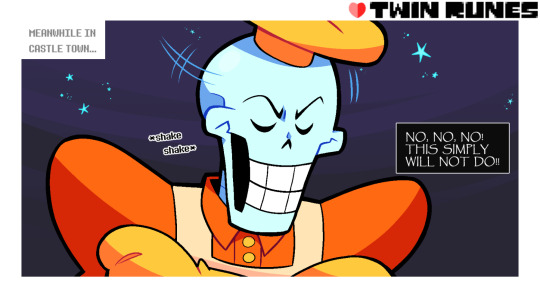
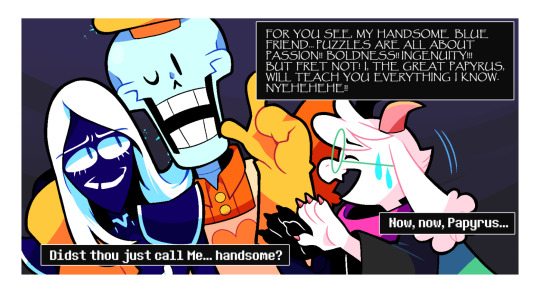
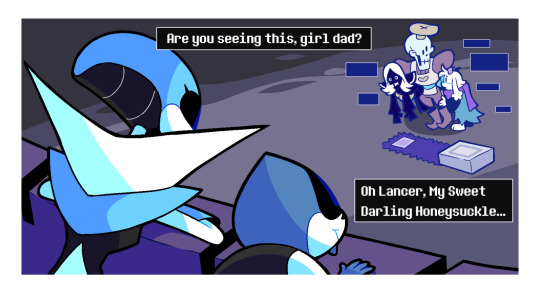

I'm sure Ralsei's gonna be fine... I hope
FIRST - PREVIOUS - NEXT
MASTERPOST (for the full series / FAQ / reference sheets)
#deltarune#deltarune fanart#deltarune comic#comic#twin runes#twin runes au#deltarune ralsei#undertale papyrus#undertale#crossover#utdr#roulxs kaard#lancer deltarune#queen deltarune#oh hey#this is the first comic without our main protagonists#time for the darkners to get the spotlight#it hasn't even been an hour and papyrus already adopted roulxs as his pupil#he'd make a greet teacher tbh#royal guard at work
6K notes
·
View notes
Text
So I've seen a few too many people on twitter talking about The Kiss Scene from the new Scott Pilgrim anime. People saying it's fetishistic and indulgent, people calling it male gazey, etc. And while the kiss itself is certainly a bit exaggerated, I felt like writing a bit about why I disagree, and why context is important, like it always is. But it basically turned into an extended analysis on the metatextual treatment of Roxie Richter. So bear with me. It's a long post.
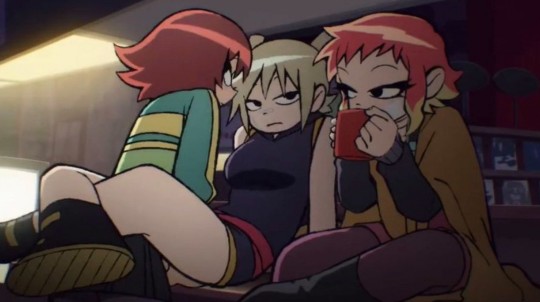
What really matters about this scene is not the kiss itself, but what precedes it. Not even just the fight scene just before it, but what precedes the whole anime series, really. And that's the Scott Pilgrim comic book, and the live action movie. Because in both, Roxie is a punchline.
She's a joke. Her character starts and ends with "one of the exes is actually a girl, I bet you didn't expect that." Jokes are made about Ramona's latent bisexuality, the movie especially treating it as funny and absurd, and her validity as a romantic interest is entirely written off by Ramona as being "just a phase." There's a fight scene, she's defeated by a man giving her an orgasm which implicitly calls her sexuality into question (come on), and the movie just moves on. It sucks. It really, really sucks.
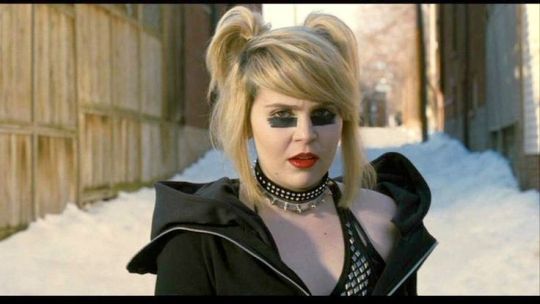
The comic fares a little better. It never veers into outright homophobia like the movie does, and while the line about Ramona having gone through a phase remains, Roxie actually gets one over on Scott when Ramona briefly gets back with Roxie. But Roxie is still only barely a character. Like all the other evil exes, she's just a stepping stone towards the male protagonist's development. She barely even gets any screentime before she's defeated by Scott's "power of love." But Roxie stands out, since she's the only villain who is queer, or at least had been confirmed queer at that point (hi Todd). In a series that champions multiple gay men in the supporting cast, the single undeniable lesbian in the story is a villain. She's labeled as evil, made fun of, pushed aside in favor of the men, and then discarded. Her screentime was never about her, or her feelings for Ramona. It was about the straight, male protagonist needing to overcome her. And that was Roxie Richter. An unfortunate victim of the 2010s.
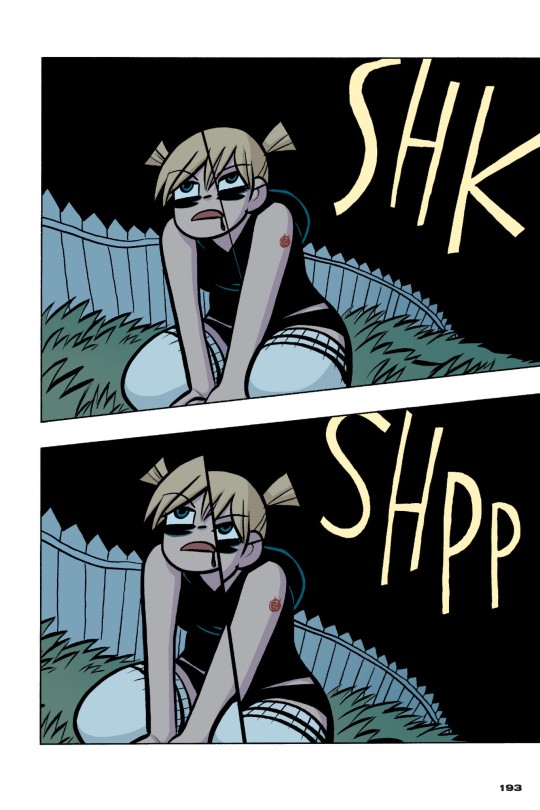
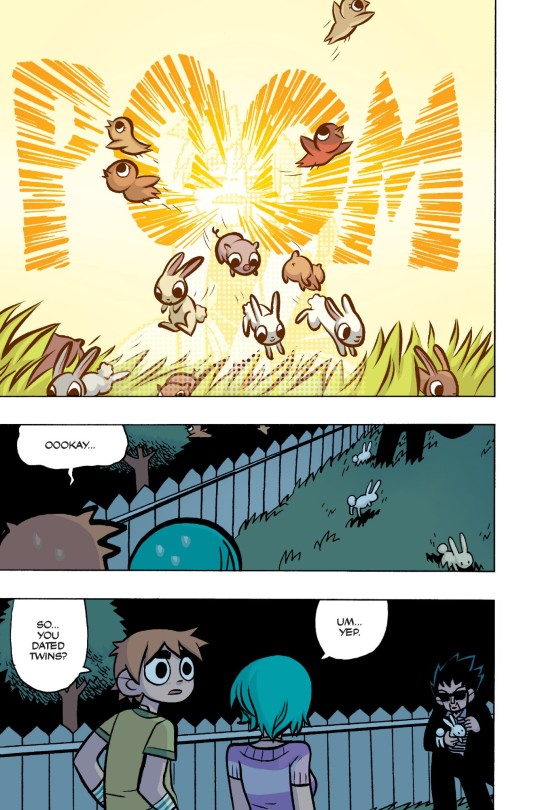
Fast forward to current year, and the new anime series is announced. Everybody sits down to watch the new series expecting another retelling of the same story, and.... hang on, that straight male protagonist I mentioned just died in the first episode. And now it's humanizing the villains from the original story. And there's Roxie, introduced alongside the other evil exes in the second episode, and she's being played entirely straight, without a punchline in sight. No jokes are made about her gender, no questions are made of her validity as one of Ramona's romantic interests. The narrative considers her important. In one episode, she already gets more respect than she did in either of the previous iterations of Scott Pilgrim. And this isn't even her focus episode yet... which happens to be the very next one.
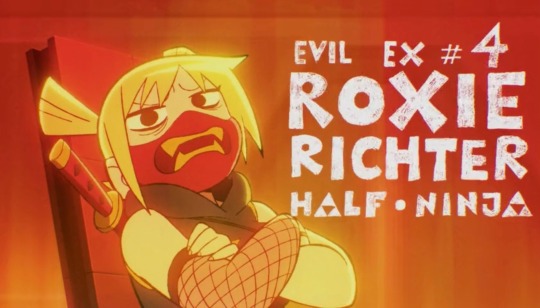
The anime series goes to great lengths to flesh out the original story's villains and to have Ramona reconcile with them. And I don't think it's a coincidence that Roxie gets to go first. While Matthew Patel gets his development in episode 2, Roxie is the first to directly confront Ramona, now our main protagonist. This is notable too because it's the only time the exes are encountered out of order. Roxie is supposed to be number 4, but she's first in line, and later on you realize that she's the only one who's out of sequence. She's the one who sets the precedent for the villains being redeemed. She's the most important character for Ramona to reconcile with.
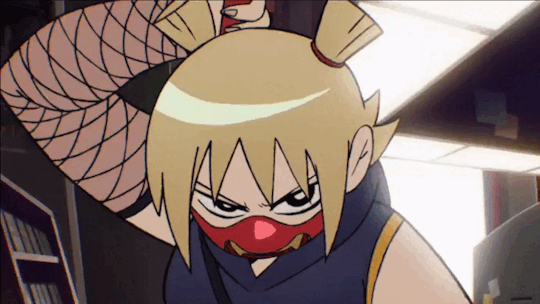
What follows is probably the most extensive, elaborate 1 on 1 fight scene in the whole show. Roxie fights like a wounded animal, her motions are desperate and pained. Ramona can only barely fight back against her onslaught. Different set-pieces fly by at breakneck speed as Roxie relentlessly lays her feelings at Ramona's feet through her attacks and her distraught shouts. And unlike the comic or the movie, Ramona acknowledges them, and sincerely apologizes. And the two end up just laying there, exhausted, reminiscing about when they were together.
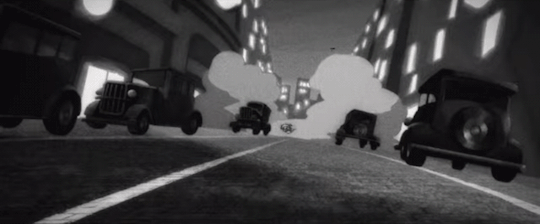


Only after this, after all of this, does the kiss scene happen. Roxie has been vindicated, she has reconciled with the person who hurt her, the narrative has deemed that her anger is justified and has redeemed her character. And she gets her victory lap by making the nearest other hot girl question her heterosexuality, sharing a sloppy kiss with her as the music triumphantly crescendos.
It's... a little self-congratulatory, honestly. But it's good. It's redemption for a character who had been mistreated for over a decade. And she punctuates the moment by being very, very gay where everyone can see it, no men anywhere in sight. Because this is her moment. And then she leaves the plot, on her own accord this time, while humming the hampster dance. What a legend. How could anything be wrong with this.

#scott pilgrim#spto#scott pilgrim takes off#roxie richter#roxanne richter#scott pilgrim spoilers#spto spoilers
19K notes
·
View notes
Text
the ignored relevance of chapter 66 (and ‘filler chapters’ as a whole) in the Kuroshitsuji anime adaptation

It’s not the first time ‘filler chapters’ are ignored by the anime adaptations, and it was never a good idea to do so in the first place.
With ‘filler chapters’ I mean chapters who are not part of arcs per se, but tend to separate the newly concluded arc with the subsequent. While these chapters are more slice-of-life-ish and comic relieves for readers after the heaviness of the main plot, and while their exclusion does not alter the plot that much, they still are important, since they give us the opportunity to get deeper into the character’s feelings, personality and psychology.
The first one to receive such treatment was chapter 14.
In chapter 14 not only we get to meet one of the most important secondary characters of the series, Francis, but we also get to know our co-protagonist even more. O!Ciel, who was mostly passive and sort of a damsel in distress in the previous chapters, brings out his competitiveness and acts with bravery protecting Lizzie without hesitation. Also, we get to know that O!Ciel is very much loved by the people surrounding him : he’s not a child left all alone, but a nephew loved by his family and a master loved by his servants.
The most recent exlusion was the one of chapter 66 by season 4 : even though most of the chapter is just a silly and fun Easter egg hunt, it’s very important especially for one thing : Lizzie suspecting of Ciel.
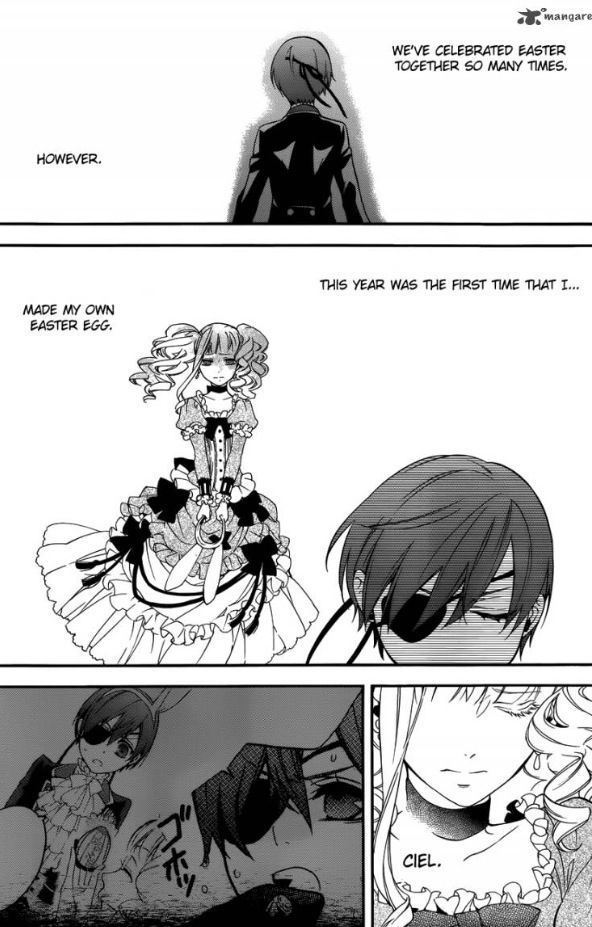
One of the most mind blowing things about the ‘twin revelation’, was the fact that it was not even in slightest random. The evidence were all over the place in the tiniest of details, the responsability to actually notice them was ours and ours only. In chapter 66 we discover that Lizzie is not so sure about O!Ciel’s identity because things simply don’t add up : the fact he got a cold so easily and quickly while on the Campania and most importantly, the fact that he lied about remembering something that actually never happened. This chapter is one of the most important clues, and pretending it doesn’t exist will just make the twin revelation (if the anime adaptations will go on until that point) random when it actually never was.
That said, I do understand that this may not be proper material for a first episode, maybe it could have been too confusing for anime-onlys or for people who will get to discover this series for the first time.
Still, I really hope they’ll at least make this an OVA, maybe using it as a way to separate the series (since, from what I’ve understood, season 4 will air in two parts). Not only it’s important for the later revelation, but it’s also a funny warm chapter that I personally enjoy very much.
Thank you for reading ♡
#kuroshitsuji#black butler#kuroshitsuji season 4#black butler season 4#kuroshitsuji manga#juneatmidnight_complains
57 notes
·
View notes
Note
WHAT DO YOU MEAN DREAM'S HAIR USED TO BE WHITE!! oh my god. i just saw your post about killala and i have now perished. thanks for breaking my heart.
but also hi!! i'm relatively new to the fandom and it's a great place to be. i haven't finished reading all the comics yet but i'm curious to know:
what do you think are the main differences between TV!Dream and Comics!Dream? i've heard so many people claiming that he is incapable of changing, for instance, and though the show does convey his overall rigidity pretty well, i'm not getting the vibe that he's immutable.
also!! it's clear that he feels a lot. which is always funny to me when the corinthian is like yo, try this and maybe you'll feel something for a change but like. he does!!! or i get the impression that he does. he probably feels too much if anything?? all of it simmering just beneath the surface, barely contained. how would you personally analyze his relationship with his own emotions?
i hope all of this is coherent enough for you to answer lmao, i saw your post about enjoying being asked sandman questions two seconds after i woke up and barged into your inbox. hope you have a lovely day!
Thanks so much for the ask, and welcome if you’re new(ish) to the fandom! 🤗
I’m sorry I broke your heart—much more heartbreak to come I fear if you haven’t read the comics yet, so I’ll try to keep this as spoiler-free as possible.
I am one of those people who believes the differences between comics!Dream and show!Dream are actually not as big as they are made out to be where it matters, and you will definitely find people who disagree. At the end of the day, we all read it through our own lens and will never be fully objective about it.
The main difference I see is that they filed off the rough edges of the comics a bit to make a new audience sympathise more. It’s very hard to do that with a character who is basically in full arsehole mode for most of the first 40 issues or so, and even then only slowly begins to come out of it (although we can obviously see glimmers of what lies below the surface at the beginning of the comics, too, but it’s far more subtle than in the show). I’ve worked in musical theatre for a over decade of my life and understand a bit about bringing the written word to stage/screen, and some things simply don’t translate well from book to stage/screen, and you have to change it. So my personal opinion is we get a more sympathetic Morpheus and certain changes so the audience can do exactly that—sympathise off the bat. You will lose an audience pretty quickly if they don’t care about the protagonist and the universe he moves in, and you can’t be as nuanced about it as you can be in a written work. We’re talking about streaming services thinking about profits here, even if people don’t want to hear it.
Also: The more you sympathise with a character, the deeper the emotional investment and the more you feel, even if it hurts.
Having said this, I don’t think Morpheus is incapable of change, and I never got where that idea comes from. His biggest flaw is that he believes he cannot change (and even he has moments when he admits he might have). In the introduction to Endless Nights, Neil Gaiman says that he was once asked to describe The Sandman in twenty-five words or less, and famously, it was this (you might have heard it):
“The Lord of Dreams learns that one must change or die, and makes his decision.”
And I think some people might have wrongly taken that for an either/or thing. I don’t want to say too much at this point because I don’t know how much you know (if you’d like spoilers or already know how it ends, let me know, I’ll happily expand on it). Only so much:
He is capable of change, also in the comics. Very obviously so. But just like he denies he has his own story (which also isn’t true), he denies he can change. Or at least he thinks he perhaps cannot change enough (it’s actually hard to write about this without giving everything away, help! 🙈).
As for his feelings: He does feel, but again, it is something he pushes down and will deny himself. Until it bursts to the surface and breaks through, and when that happens, it’s usually with, well, let’s say varying results, and that’s putting it mildly. Personally, I’d say he has problems relating to his feelings, but that doesn’t mean he doesn’t feel. Quite the opposite in my view. He holds the collective unconscious—all unprocessed feelings and whatever else floats around in that collective mess, and it’s exactly what he says to the Corinthian in that famous scene: he needs to keep a lid on it and keep that lid firmly closed so all of it doesn’t consume him. But that also means denying himself the feelings that are linked to his own personhood (if you want to call it that). There’s Dream of the Endless, and then there’s Morpheus. And while they’re one and the same and inseparable, Morpheus is also the “point of view”. The character, the person, if you will. And deep down, he craves that personhood so badly. Out of all the Endless, he is the only one who basically collects names because they mean having something beyond his function, which is also mirrored in what he tells Death in “The Sound of her Wings”: he wants something more. He is the only one whose realm is populated with sentient beings (yes, I know Despair has rats, but I think you get my drift). He is desperately lonely and struggles with it. He seeks connection yet denies it to himself. That’s not someone who doesn’t feel.
I don’t know if this answers your questions at all—I was doing the wild “spoiler-free” dance 🤣 But please let me know if you want me to go a bit deeper, I love talking about this stuff.
You can also have a look at my metas if you haven’t already. The headers pretty much explain what they’re about and what spoiler-level to expect, but none of them are truly spoiler-free I guess:
Again, thanks so much for encroaching on my inbox, and feel free to follow up if anything was left unanswered.
@dreamaturgy ask answered
#the sandman#sandman#dream of the endless#morpheus#sandman meta#ask answered#send asks#sandman analysis#sandman character analysis#sandman comics#the sandman netflix
40 notes
·
View notes
Text
With the Heian chapter of FGO soon approaching NA, I thought it would be good to make a refresher post reminding people of the basic concepts behind the main Heian cast of characters. Kinda long post. Enjoy.
Minamoto no Raikou

This character presents herself as a prim and proper lady who never misbehaves and reprimands those around her for their misbehavior. This concept is taken to somewhat of an extreme, with her attempting to force herself into a very emotionally sterile lifestyle, to a point beyond what she can humanly handle, leading to some really messy slip-ups.
The reason for overwhelming self-regulation is that this character is a mixed-blood of human and oni. And one whose oni traits are remarkably ancient and powerful, at that, so can't afford the risk of allowing herself overtly emotional responses to anything, or the consequences will be severe. Her inability to function like a normal human is a consequence of her attempts to remain human.
Another key character trait of hers, usually at the forefront, is her pseudo-incestuous infatuation with our hero Sakata Kintoki. They aren't actually related in any way, she just overlays her conscious romantic feelings with a family framing because she's a freak like that. She's also a frequent target of jokes about her chest size.
Sakata Kintoki
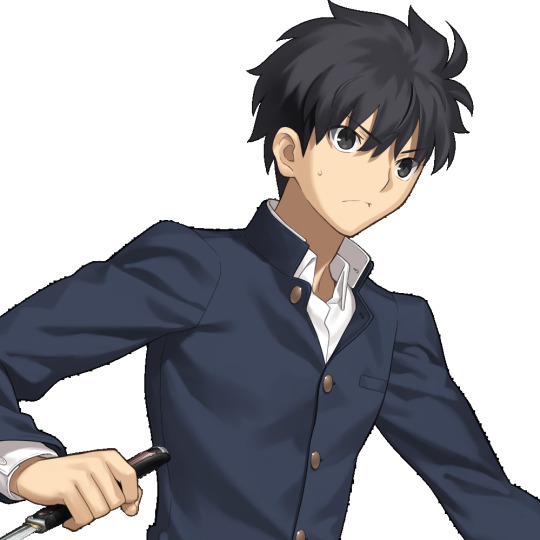
The protagonist of his cluster of characters. He was born and spent his early childhood deep in the Japanese mountains until he was brought to the big city and adopted into the house of the character above, Minamoto no Raikou, because his birth lineage makes him a powerful asset for oni slaying. One of the powers granted by his genealogy is the Pure Eyes, which makes his irises blue and allows him to see things others don't.
Despite his mountain background, his story is set years after he's already grown accustomed to civilization, but his childhood years still left him a man without concrete goals. That said, this is not a bad thing, as he's ultimately content with his simple everyday life.
Being the protagonist of a monster vs human setting, he naturally embodies the heroic virtues of compassion and willingness to be a bridge between both sides. And of course, he gets his fair share of both human and monster love interests.
Shuten-douji

Sakata Kintoki's main love interest. She's the most powerful being on this sub-cast, but she's actually a weakened state of something much greater. Contrary to the restrained half-onis, this character is portrayed as fun-loving and unstoppably free, although she still has principles she strictly follows about the nature of her species.
Her first interaction with her love interest involves him trying to slay her. As someone who always saw herself as invincible, she got very interested in his real prospects of killing her and developed a deeper relationship over time and mutual demonstrations of violence. Despite this, she's actually very insecure about the long-term viability of human/inhuman relationships and ultimately chooses to keep her distance from her love.
Ibuki-Douji

The older and more powerful entity Shuten-douji used to be. She has a far more solemn and dignified presence at first, but at her core, she's noticeably still the same character as her more recent self.
In this specific story, she's more of a setting element and plot device than a proper character, but she gets to show her personality in other stories.
Ibaraki-douji
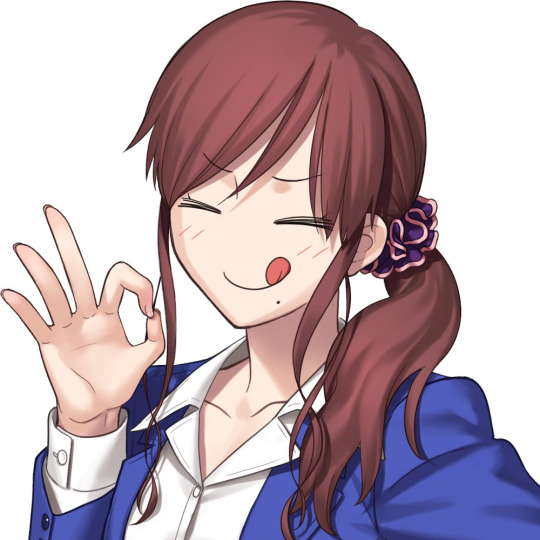
Mainly a comic relief character but with a sweet deal of tragedy hidden under the surface. She's a loser woman whose key draw is being a loser woman, but that doesn't make her any less capable of gruesome on-screen violence. Holds a huge one-sided grudge against Watanabe no Tsuna, to point this could be considered a core element of her character.
Her personal story is that of a human forced into an oppressive environment due to a suspicion that she had monster blood in her veins, until she reached a breaking point and chose to become the monster she was suspected of being. With that, she gained power and freedom but remained essentially a loser leagues below the level of her aforementioned Watanabe no Tsuna rival (although their shared history enables her to cause meaningful psychological damage).
Watanabe no Tsuna
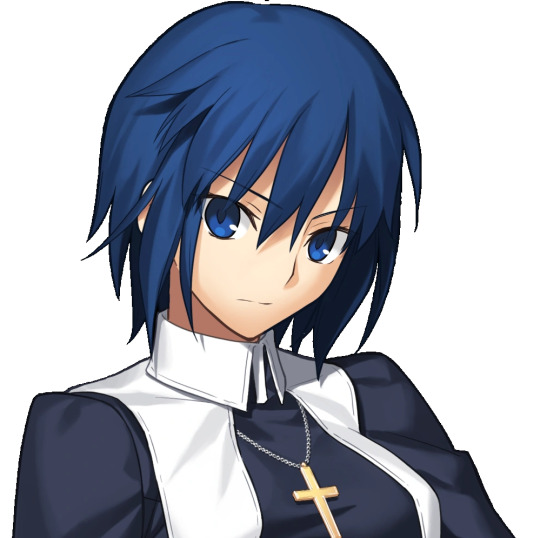
A remarkably skilled member of the monster-hunting organization and somewhat of a senpai to Sakata Kintoki. Tsuna was born as a common peasant who was perfectly fine with staying that way until the character's first encounter with non-humans changed their life.
The narration surrounding Watanabe no Tsuna loves to describe the character's non-human hunt as thoroughly machine-like, reflecting the character's habit and ability to shut down emotion and perform full self-dehumanization for the sake of a mission. Though one exception to this comes with Ibaraki-douji, as Tsuna's greatest trauma and regret is the incident that orphaned Ibaraki.
Ashiya Douman

A character presented by the narrative as a dark mirror to Sakata Kintoki, but in a that still lets him stand out well as his own character with a completely different background and personality. Character foiling aside, he also has a literal spiritual connection to Kintoki.
We actually don't see much of the actual Douman-born Douman because he spends most of his on-screen time possessed by an ethereal being who can be considered another incarnation of himself after experiencing death many times.
The flesh-providing Douman is presented as a very implicitly tragic figure in his limited screentime, while the reincarnator Douman (called Limbo for differentiation purposes) is remarkably knowledgeable of the magical secrets relevant to the overarching plot and serves as a neat window for the things to come. Limbo was also somewhat of a simp for Ibuki-douji before the events of this story made him change his mind.
And one key aspect all versions of Douman share is their comedy relief aspects, which are centered around him being the unwanted member of his group or him getting easily excited and losing the ability to shut up.
Murasaki Shikibu

A lady-in-waiting to a noble lady. Has something of a sisterly relationship with her fellow lady-in-waiting Sei Shounagon. She's actually the more naturally excitable of the duo, but the dark circumstances of her work environment made her somber, outwardly dispassionate, submissive, and courteous to a fault.
Sei Shounagon

A lady-in-waiting to a noble lady. Has something of a sisterly relationship with her fellow lady-in-waiting Murasaki Shikibu. She's actually the more naturally introverted of the duo but since the person that she cared about the most started to lose her smile, Sei Shounagon became a constantly cheerful silly girl in a questionable attempt to make her feel safer and remind her of the good times.
She went through some really bad times in the past, but her compassionate understanding of the heart of the lady she served and the knowledge about onis she gained from personal experience prevented her from acting out of hatred towards the one who made her suffer.
My favorite character in the entire game, by the way.
590 notes
·
View notes
Text


The World in Deeper Inspection UPDATE
Read: (Chapter 1: Pages 1 to 4)
About the comic
TWIDI IS BACK!
To celebrate its 10th anniversary since launch, I'm remaking the first chapter and posting pages every Friday, accompanied by my thoughts on the original pages and a breakdown of what I've changed or improved.
Analysis under the cut.
PAGE 1 and 2
It’s March 31st, 2023… exactly 10 years since I posted the very first page of TWIDI!! I haven’t done much to celebrate TWIDI’s anniversaries the past few years (due to general Busyness – yes, yes, check out the forever “TWIDI isn’t dead” sign up on the front page), but the official 10th anniversary is a special unignorable event.
Initially I wanted to make a simple remaster of Chapter 1 – better copyediting, fixing egregious lettering and art errors, alongside a retrospective author’s note… then long-time reader Caracan suggested, why not do a full remake? That’d be fun to see. And I agree – it would be fun to see! I’ve grown my craft and sensibility as comics artist since TWIDI’s debut, and I was so curious to see how 28 Year Old Me would interpret the material that 18 Year Old me produced.
So yep!

This first page used to be so cool-looking to my 18 Year Old eyes… I can definitely see what I was trying to go for, but wasn’t quite able to reach then.
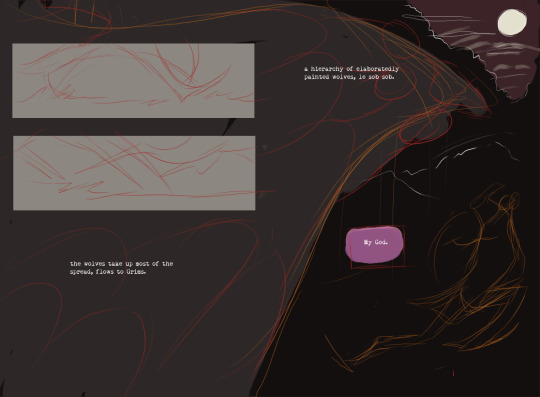
A thumbnail from 2013, with notes to myself regarding the composition. In my mind I wanted the wolves to have a James Jeanesque rendering – I was really into his Fables covers back then (still am tbh).
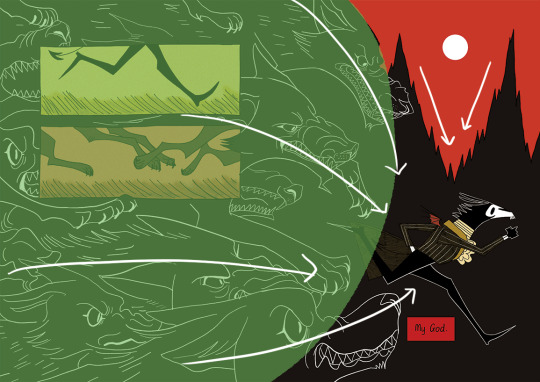
For the remake, I leaned further into the graphic-designiness of the composition: every element had to sweep the reader’s gaze down onto our protagonist. The wolves are expanded to actually take up half the spread and simplified down to only white lines. The trees and sky are shaped like teeth pointing down to Grimsley. The intent was to evoke a sense of claustrophobia, of the wolves catching up to Grims and driving him into a corner.
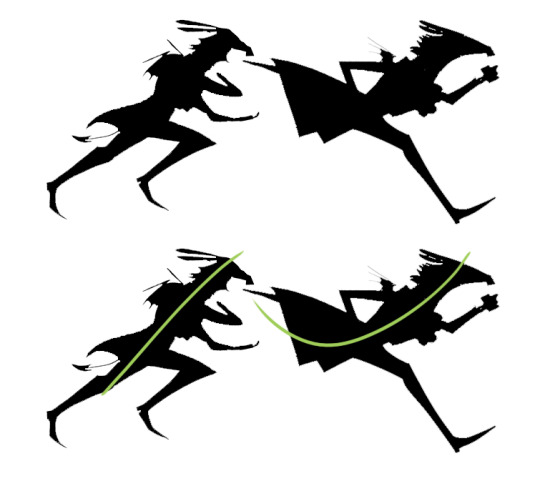
Small improvements: the energy and line of action are clearer with the new running pose. Definitely a better silhouette. And a lot more angularity with the limbs which adds to the sense of movement.
PAGE 3 and 4
This spread is one of the most drastic rehauls in the remake. Here’s the original for comparison

It’s not very good! (Sorry @ 18 Year Old Me) I remember struggling real hard with the dynamicism required out of this sequence…

Fortunately after 1000s of double-page compositions and 10 years of practice, I’ve finally cracked this once-difficult composition.
This new page does away with the concept of grids or caring about whether anything is read linearly. The sequence is supposed to evoke chaos and panic as everything is happening everywhere all at once, so it doesn’t really matter if everything can be read or arranged in a neat grid. That was the problem with the original spread: it was too beholden to the grid.
(You can see how in the original, each page was (top row: left to right; bottom row: left to right))

The new page is like this:

The page is horizontally railroaded. The main action sweeps from top left to bottom right.
The AWOOO sfx is the anchor which leads the eye from left to right. As the eye travels it may glance up or down at the panels – there’s no real need to pay attention to them; hopefully the improved clarity of Grimsley’s emotional and body acting + me actually depicting the wolf biting his neck + the spiky graphic design elements instantly conveys that he’s in trouble without much or any processing.
The newest panel – the pink grass and canine paws – is a call back for later when we catch up to this in media res.
#the world in deeper inspection#comics#webcomic#GOSH HAS IT BEEN THAT LONG#anyway yall who like reading up on process will enjoy this
111 notes
·
View notes
Note
I'm loving all these side stories exploring the DHD universe! Each one so far has been pretty great. I love alrick and his story very much, but it's fun to get to see and focus on these other characters too. Pearl was entertaining and I'm excited to see what's up with Plague
Your art is also always such a treat. I was just thinking to myself today that I kind of wanted to study the way you use background art. The grayscale filtered photos spaced out between white space without feeling empty is really hard to pull off, but I think you do so very well.
While Alrick is the main protagonist, you are right that we need to see other characters, too. It avoids stories being repetitive and gives readers a chance to mirror characters against each other; when character X is like this, and character Y is the opposite, they underline each character's traits. Whether it's their values, looks, age, gender, sex, job, living situation, dreams, fears, past, future etc. We learn about ourselves in relation to others so this same goes to characters, too.
Characters being surrounded by other characters also reveal new things from each other. Miranda can't really talk about how being a Death-Head's girlfriend affects her and the relationship with her coworkers but she can speak about it with Alrick. Joon is very lively and Miranda is super supportive of Joon, but only Alrick will understand how it is to work as a Death-Head. Plague is an ass for everyone but doesn't speak back to Kahamet (so he knows his place). Alrick is considering others but through Dio we see what happens when Alrick (or anyone) considers others above the Death-Head rules.
Also, the easiest way to expand the world or theme is to see it from other character's perspective, from their neighborhood so to say. Alrick doesn't seem to be working as a Death-Head to collect payments but Grimm does and uses this right of his without hesitation or remorse. Ama and Awa view Death-Head work as a luxury service whereas Dio does his dirty job and doesn't view the job as anything to do with luxury. Grimm enjoys being a faction leader, Plague doesn't want it. Lou-Lou is horrified with Death-Heads, Miranda lives and sleeps with one. Society views Death-Heads and their deals as something horrific, but for Pearl meeting Grimm via her deal was a lottery win. Mr. Singer loses his teeth as a payment, Cure loses her life. Rena doesn't make deals but Grimm does and can only do it because Algoth busts his ass off to give Grimm room for deals.
..
If you ever come up with something with studying my art, please, let me know! We're blind to our own work, can't see them the same way as outsiders too. I think one reason why the space doesn't feel so empty is the colored speech bubbles, which are connected to each character. I think the result would be more hollow if all speech bubbles where just blank white. The characters take more space with their colored speech bubbles. (I originally started this as I hated drawing speech lines to right character. If they are individually character color coded, then it's a lot easier to do speech bubbles!)
Why I went to comics without background was due two things. First, I didn't want to draw them. I don't enjoy them. I hate it. I don't enjoy at all thinking about compositions, perspectives, hues or values, nor about panel placements. Been there, done that, hated every minute of it. I don't want to spend my precious limited free time and limited resources on things I hate. My emphasis is on the characters and the comic is drawn in a way that it doesn't have to put emphasis on the things I hate, like panel placements and directing viewers gaze.
Second thing is that rules in art are human made. Sure, some things do make the viewing more pleasant and carry your story - I went to an art school - but many of the rules you don't need. If you are famous, you're even praised for breaking them!
I had that almost rioting epiphany when I was in the art school. I happened to see from TV news how in the modern art museums, there was a new exhibition by an American painter. He was famous for painting portraits and hanging them upside down. The curator of the exhibition was explaining with shining eyes how amazing this method is! How amazing it is that this painter challenges the viewer by hanging the paintings upside down! How revolutionary!
I thought "He gets praised for hanging paintings upside down, but if I did the same anywhere, even in the art school, I would be scolded for a cheap trick or be even called downright an idiot. So, why it is allowed to him and not for me?"
As I hate injustice like this, I've made my mind to fuck around and find out when it comes to my own art, and remember; if what I do was done by someone famous, it would be praised as something exceptional. If it's allowed to someone, then damned I be, I'm going to take that right for myself, too!
27 notes
·
View notes
Text
bitty is a deeply flawed individual, and it takes him a lot longer to grow and mature than it takes jack. let's discuss.
bitty is our narrator, so we see the world through his eyes. this makes every other character's flaws much more present to us. jack's flaws are basically the first thing we learn about him - but jack's flaws being addressed is also one of the first storylines in the comic. jack has to mature and handle his issues for the romantic storyline to even begin.
bitty is not a gary stu protagonist. bitty has a lot of complexities (restlessness, procrastination and executive dysfunction being common ADHD symptoms, which are hard to live with when undiagnosed), but his main character flaws are fear of confrontation, passive-aggression and self-sacrifice.
these flaws are easy to overlook on a daily basis, and sometimes they even present as "good" qualities (he's an extraordinarily caring friend, and he puts everyone's needs before his own), but the moment he enters a romantic relationship this becomes a huge problem.
dating someone who won't tell you when something is bothering them is incredibly difficult, especially when you have anxiety. it leads to mistrust (you ask them if everything's okay and when they say yes you know they're lying) and emotional distance (you open up and rely on them but they won't do the same). not knowing if/when something is wrong, and thus not being able to fix it, is a huge trigger for anxiety disorders. plus, a lack of fighting is not actually a good thing in relationships. fighting is the way to bring up issues and find common ground in order to solve them. no confrontations = no solving.
often in pop culture, once a relationship is established, you know the drama is coming. writers need to keep things interesting to keep the audience engaged. hi honey's blog post makes it clear that ngozi knew this, and for only a second baits the readers with the possibility of a break up, but the drama actually comes from a much more genuine and realistic source: bitty needs to own up to his problems, and needs to learn to face them and openly communicate them to his partner, and needs to learn to accept confrontation as a way to solve these problems, or he and jack are simply going to break up. just as we wouldn't expect bitty to date jack if jack hadn't handled his issues, jack can't date bitty if bitty doesn't handle his own.
the beautiful thing about this (and the thing many readers seemingly missed), is that hi honey isn't even about coming out. bitty's main problem isn't being unable to tell people he's dating jack; that's a secondary problem that they solve by giving bitty a safe place where he can be honest with his close friends. bitty's main problem is that he spent six months carrying the weight of his isolation alone, without opening up to jack about it, which only served to make him feel more helpless and more alone. this put a much heavier burden on their relationship than being closeted did.
in conclusion: hi honey is, much like playoffs/banquet for jack in year 1, the comic where bitty's character arc comes to its first peak, and is an important and necessary milestone.
#omgcp#omgcheckplease#eric bittle#I'm going to expend on a part of this in the tags because this isn't the main point of the post:#many readers complained that omgcp advocates coming out as a necessity to being happy. it doesn't.#BITTY - personally - needs to be out to be happy. that's true. but it's a result of his upbringing and lifelong trauma#it's not a general statement for every queer person out there#following that - being closeted is only secondary in hi honey because once they tell their friends#bitty rarely talks about struggling with being closeted.#obviously they want to come out and obviously they're the sort of couple who wants to be open and honest and not have to hide#and that's where the cup kiss comes from#but bitty struggles more with lying to his friends and feeling like he's lot his safe space and his home#and THESE things are solved in hi honey. not by coming out to the world#(of course it should be mentioned that the world also contains bitty's parents#which is why the cup kiss is even so significant to bitty at all - but that's another matter)#text#meta
227 notes
·
View notes
Text
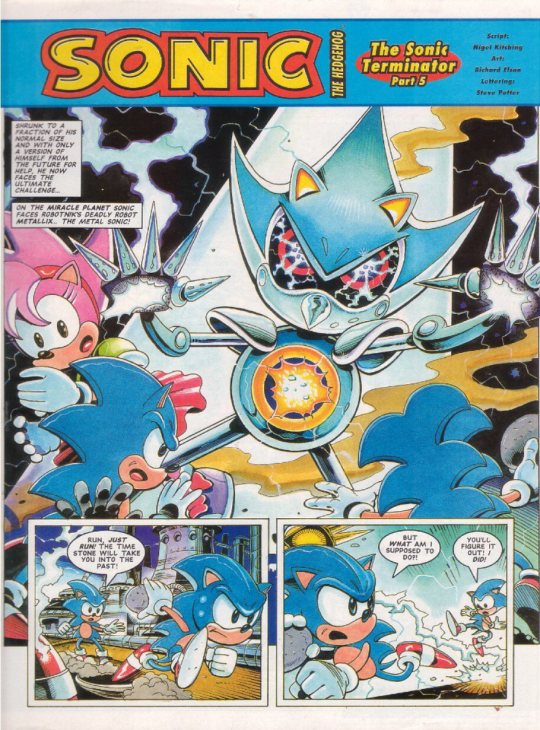
I can now say for sure that this is the final part of the biggest Sonic story in StC so far. Five parts is nothing to sniff at and everyone one has been an epic. This climax promises to go strong, with the threat of Metallix hanging over our heroes. Sonic learned at the end of the last issue that whatever he does in the past, it might not stop Metallix after all, yet still he has to take the Time Stone and go on blind faith alone
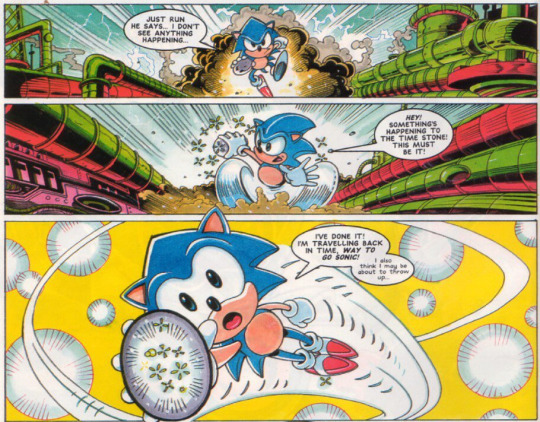
Anyone who’s played Sonic CD will be familiar with this mechanic. Although admittedly, I could rarely get it to work and have never managed to get the good ending myself lol…

Like in the game, after travelling back in time, Sonic needs to destroy these machines to create a good future. But there’s a few differences here for the sake of the story adaptation. The first being that the machine itself is growing into the Miracle Planet. I actually can’t remember if that was the case in the game or not, but it’s a cool addition either way and works with StC’s more brutal takes on the way Robotnik’s technology works. The second is that Sonic needs to go inside the machines to break them, which he can do by being shrunk down small. These two features had no connection to each other in the game, but I like that they’ve linked them here for a smoother story transition. And third…

…the machines are powered by the Time Stones, with removing them being what breaks the machine. It’s a neat way to work the Time Stones into the plot without including the special stages, which would’ve taken more time to establish
Now that I think about it, the Time Stones replacing the star posts as Sonic’s method of travelling through time in the game is also good streamlining for the sake of the story

Also nixed from the story is the second machine you need to destroy, the Metal Sonic hologram, which in the game would make the small animals appear unafraid of Sonic once more. There’s really no need or extra time for that here, as Sonic warps back to face Metallix in the present day, just like he knows the past version of himself did before
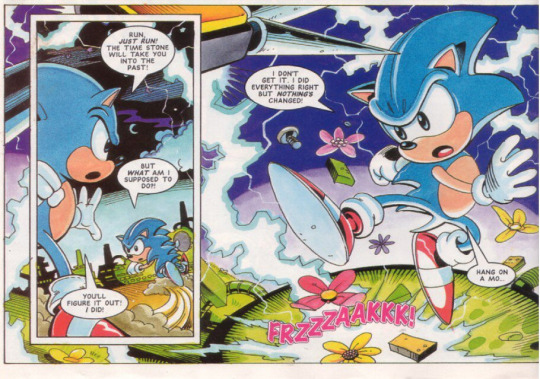
Now Sonic is back here and after watching the scenes play out in the same way, we get to see what comes next. Except that he doesn’t know what’s coming next himself, as whatever he changed in the past hasn’t affected the future. But wait a moment…
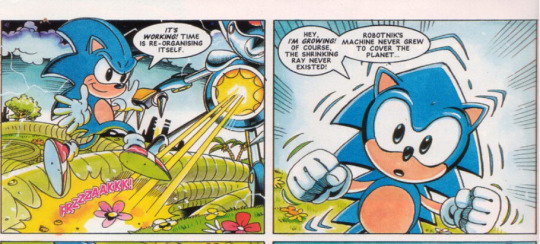
…Oh come on, it wouldn’t be a dramatic reveal if the changes to the timeline happened instantly. With everything Robotnik built on the Miracle Planet (or infected it with?) now gone, no shrink ray means that Sonic is no longer small

Which also affects Metallix! Huh. I know Metallix comes back to StC in a big way (which again, mostly happened before my time), so I’m looking forward to seeing how that pans out. A lot more than our aromantic protagonist is looking forward to spending a month trapped with Amy, I reckon
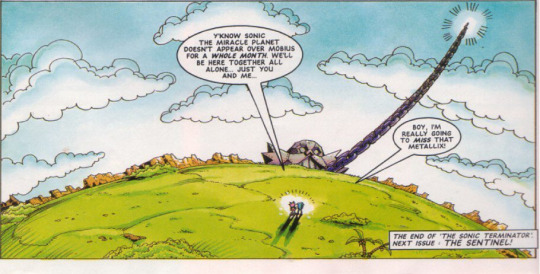
And that wraps up our epic! I feel like I’ve said most of what I could already say to sum up while I was reading through - this story had the gravity that a Sonic CD adaptation deserved. It wasn’t afraid to change things up for the sake of adapting game mechanics into the comic more smoothly, but at the same time it really did show off a lot of what you could do in Sonic CD. It genuinely felt like this was a story written by someone who played and enjoyed Sonic CD and wanted to make a story out of it, as opposed to being a game tie-in that was mandated to be written
I suppose some could argue that the first two parts being about Captain Plunder could’ve been a separate story to the Sonic CD adaptation, but I am a Captain Plunder celebrater (which is a step up from being an apologist) and think that a big member of the StC rogues gallery deserved a big introduction, too
So yes, this feels like a big milestone in StC. We have two specials to cover before getting back to our next Sonic story in the main comic, but I’m sure that the momentum they’ve built up with this story arc will keep going after this short break
Also, before I forget, I thought there was something to do with Porker Lewis on the Miracle Planet that happened in this arc, but either that happens in a different story or I'm just remembering it wrong. Just thought I'd say that, since I brought it up in one of the last issues
9 notes
·
View notes
Note
hi i wanted to let you know i have been into miraculous literally since PV days but have strayed from the fandom since around season 2-3 when "salt" stuff started getting really popular. i was tired of seeing my favorites being mangled beyond recognition to fit some weird revenge fantasy, so i just stopped. recently though i missed the blorbos. its people like you who genuinely love the show and the characters that have made my more recent experiences incredibly lovely and fulfilling. thank u :]
Aw thank you honey :’) truly as someone who got a little in to ML in 2016 and enjoyed the cute fan content and saw how much fans praised it but didn't keep up with it, only to come back to it a couple of seasons later and see how insane the fandom had become over those few years .... it is truly exhausting and baffling to see what people do to the show now. Ig this is the danger of too much self-projection and a lack of critical thinking. Even people who claimed to be done with the show in season 4 continue to run blogs obsessed with """criticizing""" the show for the stupidest and most petty things possible on a daily basis, instead of just ... walking away from it if it doesn’t appeal to them anymore. It can really give you a headache.
But it all makes me think of that one quote from the end of Ratatouille (the movie which is indisputably Pixar Animation Studios' magnum opus): "the bitter truth we critics must face, is that in the grand scheme of things, the average piece of junk is probably more meaningful than our criticism designating it so." ML as a show means so much to so many people of all age groups and backgrounds across the world. ML is far more meaningful and loved and contributes far more to the world than any random schmuck's salt post/fic/comic/video essay about it on the internet. ML is a sweet show! It's a cute and fun show! It's a kind show about emotions and relationships (platonic and romantic) and the power of love but isn’t designated as a Girls Show(TM), as shows with these themes often are, so boys are watching it too! And it shows us a male superhero being soft and sensitive and a hopeless romantic and in touch with his emotions without shame and a female superhero who loves him for it! Which is so important!
Similar kids cartoons when I was growing up, things like Danny Phantom, always had the romance as not an A or B or even a C plot but basically a Z plot. Literally on the back burner. An afterthought. Not something that was created out of passion and a belief that the characters would love each other and rather just thrown in because a main heterosexual relationship for the protagonist Has to be there, for some reason. Romantic moments would be limited to The Romance Episode(TM), wherein the "romantic development" is just like ... the characters accidentally held hands or kissed or something, and would often boil down to "this boy and girl are friends so OBVIOUSLY they have to like each other," without ever really showing me why they actually love each other. And don't get me started on allll the pieces of media with a forced heterosexual romance that is little more than "this male and female character have romantic and sexual tension because they're a male and female character." Or all the pieces of animated kids media where the main male character immediately likes the main female character because she's The Pretty One (As much as I love ATLA and k/ataang, even ATLA did this in the first episode). This all always felt so lacking to me as someone who was so enamored by love even as a kid.
Then comes along ML. Chat Noir didn't fall for Ladybug because he saw her and was taken with how she was Pretty. We know he thinks she's beautiful but he was completely unaffected by this fact when he first met her!!! It wasn't until he saw her stand up to evil that he fell for her! A male character falling for a female character not because Wow She Pretty but because of her bravery and cleverness and determination to stand up to evil and do good? That shouldn't be groundbreaking but it is!!! And it's beautiful!!! And Marinette didn't fall for Adrien because he was The Hot Guy or The Cool Hero or just because he's the male character and she's the female character so she just Has To. She fell for him when she saw his vulnerability and kindness!!! I would've LOVED to have grown up with a show like ML.
God the romance? I’ve never seen so much delicious Yearning in any other western kid’s cartoon. The door scene? Hoowee.... The way each of them so desperately wants the other to see both sides of them. The ending scene of Glaciator, when Ladybug is supposed to be “rejecting” Chat Noir and Chat Noir is supposed to be giving her a platonic cheek kiss, and yet it’s one of the sweetest and most utterly romantic scenes in the show. The sad undertone of Ladynoir, of being best friends but not being able to know a single thing about each other’s lives. The pure romance of the umbrella scene. The coup de foudre.
And it doesn't matter if the episode is romance-centric or not because ML has given us a male and female hero duo with so much genuine love and affection for each other that it's palpable in every episode from the very first season (especially if you’re watching in French lmao). Just... the sweet way they talk to each other, where you can hear their fondness for each other in their voices. The way they tease and roast each other. The petnames. The way they support and protect and take care of each other in and out of battles (specific moments like Ladybug looking after and reassuring Scaredy-cat Chat Noir in Reverser and Chat Noir putting Ladybug’s yo-yo over her mouth for her so she could breathe underwater in Truth make me so insane). The whole concept of “them against the world.” The way that even while loving Ladybug, Chat Noir has no problem telling her when he disagrees with her. The way they will have disagreements/conflicts that are completely in line with their established character traits and weaknesses, but aren’t able to stay mad at each other for more than a minute because of their softness for each other, and always come back from it because above all else they care about and love each other. It’s so unmatched. That’s love bitch
Speaking of how their conflicts are completely in line with their established character traits and weaknesses - the characters are incredibly deep and human and consistently written with motivations and personalities and flaws that all make so much sense! And they’ve developed so much since the start of the show! And the two protagonists mean so much to and resonate with so many people, kids and adults alike. Plenty of people have gone in to the depth of Adrien’s character and why he’s meaningful to people for paragraphs on end so I won’t repeat that, but I rarely see people talking about the beauty of Marinette’s character so I just have to point out like... A female superhero who is not a Strong Flawless Girlboss Who Needs No Man but one who is basically a female Peter Parker? A female superhero who is awkward around her crush and kind of Ridiculous and a hopeless romantic who makes stupid lovestruck faces at pictures of said crush and likes girly things and the color pink and wants to hold her boy’s hand and barely has her shit together and sometimes makes bad choices but is ultimately trying her best to balance her Great Power and Great Responsibility with her civilian life and relationships? Like, I’m not in to comics so sorry if this is inaccurate because I’m only pulling from Spider-Verse, but even Marvel’s attempt at making a girl Spider-Man through Spider-Gwen made her this cool badass with an undercut. I don’t want another Black Widow or Captain Marvel or whatever!!!! I love that ML basically gave us a female Spider-Man who is just as much of a complete disaster as Peter Parker was (talking specifically about Tobey Maguire and Andrew Garfield versions). I love the way both Peter and Marinette fuck up and make mistakes and bad choices and struggle to balance their two lives and accidentally end up hurting or pushing away the people who are close to them while they’re trying so hard to do what they think is right and protect the people they love with no real guidance. The loneliness of keeping their identities a secret through all that knowing that one slip up could put everyone they love in grave danger. Not to mention Marinette’s very blatant neurodivergent coding that is so clear in everything she does? Seeing her ADHD brain basically become her strength when she’s Ladybug through the bizarre connections she can make with random objects in a split second, just like how someone with ADHD would go on seemingly bizarre and random tangents mid-conversation because their brain latched on to something and quickly made a whole bunch of connections in a short amount of time while the other person was talking? Chef’s fucking kiss baby.
And I love the episodic adventures format!!!! Lots of people do!!!! The rewatch value of every episode is so good!!! Not everything has to be a 10-ep-per-season HBO drama where each 1 hour long episode is solely focused on moving the plot? People who ask for which episodes are important and which ones are “filler” that they can skip when starting ML are so weird. The fun of ML is watching all of Ladybug and Chat Noir’s fun adventures together in every episode? I love watching them just Being Ladybug and Chat Noir while they fight bad guys and have their banter. Episodes can just be Fun!!! Episodes can just exist to BE fun and silly or to explore a specific friendship or relationship rather than being focused on the main villain plot and that’s not a flaw!!!!
tl;dr: ML is a fun and cute show with very relatable, human characters and shows a beautiful, deep, powerful loving relationship between its male and female superhero leads that a lot of similar cartoons and even movies aimed at adults can’t pull off and a lot of people genuinely love this show because of it.
163 notes
·
View notes
Note
hi I am sending you an ask to serve as permission to loredump on the other thing you are working on!!
YIPPEE OH GOSH I HAVE SO MUCH TO SAYYY
Ok so I have a plan for a story (Likely in comic form) about a dysfunctional found family parent + child combo that basically has to brave a world completely ruined by constant warring and needless destruction (so yeah the tones gonna get a little bleak at times).
At this point, no one even knows what they're fighting for anymore. It's just been meaningless bloodshed for as long as so many can remember. What peace and society remains is dominantly ruled over by oppressive military factions trying to maintain what little hold they can over what there is to grasp at. Massive metal cities serve as the strongholds for the livelihoods of those left.

Resting between these oppressive bastions lies the Abyss, land ruined beyond what these military groups found useful, polluted and destroyed. The scraps of life before the unending wars, the cities mercilessly pillaged in a mindless race for power, and everything else lays scattered about, overrun with toxic plant life and dangerous undocumented fauna.

Walking the abyss are our two main protagonists, Lucy Diggz and Allison Dudz. They, among others share a similar disdain for the crushing life lived within the metal walls of any of the military factions, and fled to live a life with some degree of freedom.
Now, some character introductions! Up first, Lucy Diggs (He/Him)!


"His loose fit fire retardant suit clung to his body, discolored with age. Gloved hands wrapped around a heavily dented metal canister and his makeshift flamethrower’s hose. Lucy’s exhausted body could barely keep him up. His stance quivered, threatening to drop him at any moment.
It only occurred to him now the likelihood that his freshly destroyed surroundings were his doing."
Lucy is a bombastic hothead teen rabbit and unwilling vessel for a force called "The Vision", which grants him a power he doesn't seem to know how to harness quite yet, but also causes him to have trouble keeping himself in total control, as something else occupies his body now, too.
Unfortunately his problems don't end there. Those warring factions see Lucy as nothing more than a utility waiting to be capitalized on. "The Vision" and all of its abilities have the ability to drastically sway the tide of the endless wars, as they have many times before. Therefore, those who possess it are seen as a priority as a weapon to collect to get headway in the nonstop fighting. There also seems to be something else that has taken interest in him.
Much of his life was spent alone, walking the abyss trying to keep himself busy. the area he roamed wasn't patrolled very often, so it was mostly easy pickings for a simple, if a little boring life.
Up next, Allison Dudz! (She/Any)
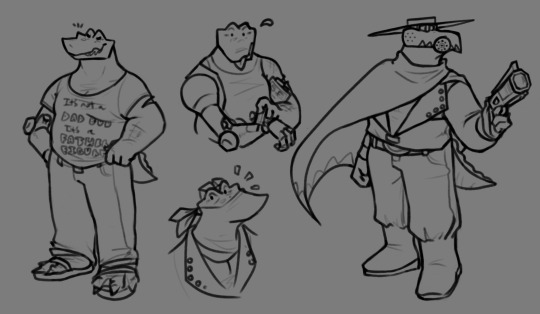
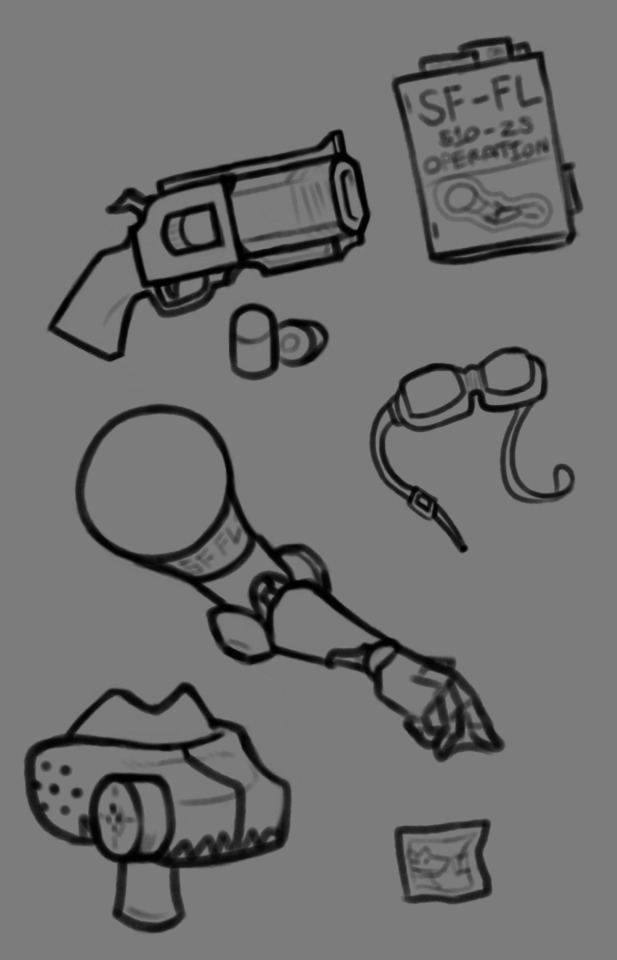
"His vision was too faded to tell much about the figure. Crude teeth were painted on their bloodstained mask. Their heavy jacket clung tightly to their frame, easily showing off their brawny figure. They towered over Lucy with ease, casting a shadow that covered his entire body.
Lucy didn’t even notice the sensation of the hand that wrapped around him, or how he was being lifted up with such little effort. All he knew is that he was now face to face with this unknown person. The avatar of death for all he knew. This was how he died, wasn’t it?"
Allison is a very mellow person, and a bit of a goofball! Though she also won't pay much mind to common social courtesy if the situation calls for it. She'll be the first one to tell you how it is without any kind of sugarcoating or fancy language. She's also often unintentionally intimidating, but since having learned this, has taken it to her advantage to scare off any of the more weak willed assailants she has to face in her day to day life.
Running what is essentially an Abyss safe haven, Allison has lived a colorful life with her various encounters with those who roam the Abyss. She's also the first to respond to distress calls in her little patch of the Abyss, and takes immense pleasure in muddying transmissions between military forces.
Together, these two brave the long since abandoned parts of the Abyss in the hopes of one day rebelling and somehow ending this war.
#hat answers#lore dump - the abyss#my ocs#my art#Lucy Diggs#Allison Dudz#I'VE BEEN MEANING TO TALK ABOUT THIS FOR SO LONG
27 notes
·
View notes
Text
Morality in Wolf 359
A month ago, I made this post about how Wolf 359 doesn’t have any good or bad characters, just people making choices. I also said I’d write a full-length essay about this topic. Well, here’s the essay! Be warned, it’s a hefty 2400 words, because I wanted to be thorough. If you don’t want to read all that, here’s a TL,DR.
People who were interested in reading this: @commsroom, @a-side-character, @firstofficerrose, @afrogsmoraldilemma
Now without further ado, the essay, below the read more.
Wolf 359 is fantastic for many, many reasons, one of the most prominent being its amazing cast of characters. The podcast is practically a masterclass in interesting and nuanced character development, and a huge contributing factor to this is the continual subversion of the hero and villain labels. As Wolf 359 continues into the later seasons, it becomes obvious that while these roles exist in the narrative to an extent, they are not nearly as black and white as we would expect. There simply aren’t “good” or “bad” people of Wolf 359; there’s just people, making decisions, and those decisions can either hurt people or help people.
Wolf 359 is an utterly unpredictable and insane story, with constant (and might I add, incredible) plot twists. There is, however, at least one predictable cycle, which I like to call the “villain escalation”. Basically, the previous “bad guy” gets replaced by another, even bigger threat, which demotes the old villain to “morally grey supporting character”. The new threat forces our main protagonists to cooperate with the old threat, leaving room for the old “bad guy” to change their behavior and develop more complex relationships with both the other characters and the audience. Now, this isn’t the only way Wolf 359 removes the hero/villain labels from the equation, but it’s one of the most prominent. By my count, it happens 3 times over the course of the podcast, though that could be extended to 4 or even 5 depending on how you classify a “new threat”.
The first subject of villain escalation is Dr. Alexander Hilbert/Elias Selberg/Dmitri Volodin, caused by Captain Isabel Lovelace. Hilbert starts as such a stereotypical villain it’s almost comical. I mean, the evil Russian scientist is manipulating our heroes and performing unethical experiments on them; it can’t get much more stereotypical than that. Then Lovelace comes aboard, and suddenly he’s an ally against her. It’s a very uneasy alliance to be sure, but an alliance nonetheless. (Note that Eiffel and Minkowski do accept help from Hilbert before Lovelace arrives, but it’s mostly done by force, and the real turning point in the perception of his character occurs after she comes to the station.) Through this alliance, we learn more about Hilbert: his past, his motivations, his personality. He’s brutal sometimes, yes, and cruel, and externally callous. But he is also motivated by a genuine desire to save people. He had a family, a sister, who fell victim to radiation poisoning, which inspired him to pursue science and push further. When Eiffel is sick, he does everything he can to save him. He repeats over and over again that he did the things he did out of a sincere desire to make the world a better place. Dmitri Volodin is not just an evil monster, and for most of the podcast, he’s on the side of the “heroes”. This pushes the audience and even some of the main characters to start genuinely caring for him, to some extent.
Crucially, though, this does not absolve him. Hilbert may not have been causing pain and death just for the fun of it, but still he did cause pain and death. And it’s all for nothing, anyway, because the Decima experiment is a failure, but even if we ignore that fact, what he did was unjustifiable. (We shouldn’t ignore that failure, btw, but that’s a topic for another essay.) It doesn’t matter what “greater good” he was working toward – he committed atrocities, and there’s no justifying that. And none of the people he has wronged ever forgive him. They work with him, they talk to him, even protect him if necessary, but forgiveness is never considered. Alexander Hilbert, while maybe not a bad person, is certainly not a good person. Even after his death, he doesn’t get to be redeemed.
I said before that this development comes as a result of the villain escalation, from Hilbert to Lovelace. That’s true, considering how I defined villain escalation, but it’s important to clarify that Lovelace was never an outright villain, instead existing as a morally grey character from her first introduction. She absolutely and seriously threatens all the main characters, making it very obvious that she will hurt them if she needs to in order to reach her goal. But at the same time, she’s their best shot at making it off the Hephaestus alive. It’s also clear that that Lovelace’s aggression, paranoia, and callousness comes from a place of trauma, and that despite her harsh exterior and frequent threats, she does want to get everyone out of this situation alive. She cares about them, in her own way. Really, I think her character in season 2 can be summed up by two occurrences. In episode 26, she saves Doug Eiffel’s life, on purpose, with her blood donation, but in episode 28, she very nearly kills him, on accident, with her explosive rig. She wants to save people, but her paranoia and rage makes it so that she hurts people instead. And just as it was with Hilbert, her trauma is not an excuse. What matters most is whether she helps the people around her or harms them, and in season 2, she does both in equal measure.
We also see an interesting dimension of morality in the interactions between Hilbert/Selbert. The worst of Lovelace comes out when she’s with him. He’s the one who killed most of her crew, so she wants revenge on him personally almost as much as she wants revenge on Goddard Futuristics. In seeking revenge, she becomes her worst self. She gets violent, self-centered, becoming willing to hurt any number of people to reach her goal, in a way that is explicitly portrayed as a foil for Hilbert’s obsession with the Decima virus. It’s interesting, because when you compare them, the more “villainous” character, Hilbert, has significantly more noble intentions. Potentially saving lives with a revolutionary medical treatment is a lot more moral than tearing down the people who hurt you. And yet Hilbert is not more moral than Lovelace. This shows that intention is not as important as the effect you have on the people around you. It also shows how goodness is not innate, because Lovelace and Hilbert are quite similar in a lot of ways; they’re both consistently down with murder, for one, but there’s more subtle similarities as well. Thus the reason Lovelace is placed closer to the “good” end of the spectrum by the narrative can’t be because of some inherent morality. Instead, it must be because over the course of her life she has helped people more often than she has hurt them. Hilbert, on the other hand, has hurt much more often than he’s helped. Their day to day actions and decisions are what give them their moral statuses and roles in the narrative, not some designated classification of being a good or a bad person – both of them aren’t either.
The 2nd instance of villain escalation comes when the SI-5 board the station. At this point, we’ve been somewhat primed to view characters in moral shades of grey, but it’s still pretty obvious that they’re “bad guys”. There are repeated references to atrocities the SI-5 have committed, and they never let the main characters forget that they are in charge and that they would do terrible things to them if the situation calls for it. They’re opposite Lovelace, in a way, in that they are externally friendly, pleasant, and helpful, while being internally willing to harm any number of people. But still they’re human. Still they don’t deserve to be murdered, as Eiffel repeatedly reminds everyone.
The SI-5 members claim, as Hilbert did, to be working on behalf of a greater good that’s worth plenty of immoral actions (though to be honest, I’m doubtful how much they really believed that and how much they convinced themselves of it just because they liked being a part of something. But that’s a topic for another day). And as with Hilbert, this is not a justification. It’s more of the same, really. Maxwell cares for and helps Hera, but she still violates her autonomy in a pretty brutal way. Jacobi breaks after the mutiny, and in his brokenness becomes sympathetic, but still is not a completely good person. Then the 3rd and final villain escalation, the arrival of Cutter and Pryce, push both Jacobi and Kepler to make the decision to do the right thing and help the people around them. It’s not that any of them become good or become bad as things progress, or even that they were good or bad in the first place. They always had the capacity to do good things, we just didn’t see much of that side until the stakes got high enough. Their character shows in the decisions they make and the sides they choose to stand on.
Villain escalation is not the only way Wolf 359 flips the script on “hero” and “villain” roles. It also shows us that the protagonists, the “good guys”, can do bad things, and those bad things aren’t justified just because the people are good. Minkowski and Hera are lesser examples of this. Both of them hurt people: Hera tries to kill crew members multiple times and often lets her anger get the better of her, while Minkowski occasionally advocates for murder and actually does kill Maxwell. Minkowski also can hurt the people she cares about in a misguided attempt at leadership, such as when she sends Eiffel away in the finale. But again, these examples are relatively minor, though they are a further illustration of the fact that even seemingly good people can cause harm. The biggest subversion comes from Doug Eiffel.
For the first half of the podcast, Eiffel is portrayed as a semi-irresponsible goofball, who can be a bit of an ass but who is at worst harmless, and at best a resourceful and honorable man. This character assessment doesn’t stop being true, exactly. However, after about 40 episodes, we learn that he is also a man who ruined lives, for completely selfish and destructive reasons. That’s not something you can just overlook, or forgive. Once again, there’s no justification or absolution, even though Eiffel was at rock bottom and struggling with addiction. He did something awful, full stop, and our previous perception of him as a good person is flipped completely on its head.
Eiffel’s also shown to be a bit of a shithead even in the present day, on the Hephaestus. He commits microaggressions frequently as discussed in episode 51, “Shut Up and Listen”, and when confronted with this, he goes sullen and withdrawn. The harm there was unintentional, but it’s treated as just as real and damaging as all the other crazy threats the crew faces. This is a unique case, because Eiffel is actually forgiven by the people he’s wronged (Minkowski, Hera, and Lovelace), but that forgiveness comes because he made a tangible effort to do better, not because “he’s a good guy at heart” or some similar BS. All this is to say, Doug Eiffel isn’t necessarily a good person. He does good things and he does awful things, but because he makes the decision over and over to be helpful, and moral, and better, he is someone that the audience can root for.
I hope by now I’ve fully convinced you that Wolf 359 does not have any heroes or villains, merely people who are working with what circumstances they have, making decisions to either help those around them or harm them. This is a fairly radical position for a piece of media to have, with clear implications for the justice system and punishment. Wolf 359 doesn’t hesitate to explore those implications, either. It is extremely obvious that killing people, even if those people pose a threat to you, even if those people are seemingly reprehensible, is always immoral. The “villains” are kept alive whenever possible, and in those moments where they are killed, it is never a victory, always a tragedy. Mr. Cutter might be an exception, though I imagine Minkowski will still struggle post-canon with the fact that she took his life. That has interesting implications in the anti-capitalist part of the show’s messaging, as it implies that once someone causes a certain level of harm (as billionaires do), killing them becomes the lesser of two evils despite not being a moral act in and of itself. But honestly, I don’t feel equipped to unpack that right now. I will just say, that Wolf 359 wholeheartedly condemns capital punishment, which is of course a necessary consequence of the idea that people are not fully good or bad. You cannot kill only the bad people, because there are no bad people. Therefore capital punishment is just murder, and it cannot be justified.
I also really appreciate this position because it’s distinctly different from a redemption arc. No one is redeemed for their past. Hell, most of them don’t even apologize for their past behavior. They just start doing better. That’s a level of nuance I’ve almost never seen, and it offers fascinating commentary on the ideas of restorative justice. Wolf 359 tells us that even people who do awful, unforgiveable things can do better. No one is in a fixed moral position, and everyone is shaped by their circumstances. But importantly, this does not mean that you have to forgive anyone! You can rehabilitate, work with, and respect people while still recognizing the atrocities in their past, and while still withholding forgiveness. It’s a remarkable endorsement for restorative justice and a really important viewpoint to consider.
In conclusion: Wolf 359 is a fucking amazing podcast, guys. The writing is masterful, and it is incredibly fun and emotional, while also providing a cutting criticism of the current capitalist global system. In regards to morality and justice, it refutes the idea that people are internally “good” or “bad”, instead recognizing that everyone is just a person who does good and bad things, and the balance of these actions can change over a person’s life. This leads to a subtextual endorsement for restorative justice that is very radical (both in the leftist sense and in the cool sense). Overall, it’s a fascinating analysis of human nature and an excellent commentary on how we treat others. I love it so so so much.
#wolf 359#wolf 359 meta#she's finally done yall!! pretty proud of myself for actually finishing it#hope you enjoy and that it's coherent :)
243 notes
·
View notes
Note
33, 40, 45 for the oc ask meme?
Woah I finally have a proper day off without having anything scheduled! So some more oc ask doodles it is because I still have a bunch of these in my askbox ✨🧡
33. Your shyest OC?
Rhiam. Though often during any kind of intense moments like in fights Rhiam gets into some kind of flow state where they just act on intuition (because they don't have time to overthink).

45. A character you no longer use?
Oh so many! But at the same time I don't know? Because I tend to have some active stories and characters I rotate in my mind and some stories are kind of abandoned (for now), but time to time I pick some old characters from them and reuse them in some new setting. Here's one that I haven't been tempted to recycle though:

I don't even remember did I name her anything besides Queen. She was a cold monarch in the first version of my oldest proper story and one of the story's main antagonists. She was replaced with other kind of antagonists over time as the story developed. She wasn't very deeply developed since I was like... 14? when I made the story. She was obsessed with keeping the power in her hands which drove her to severe paranoia that made her blame the story's protagonist's love interest of stealing the magical crown jewel and the protagonist was to find the real culprit. Her son Lumi, on the other hand, who was just a side character in the original story, became a more important character in the later versions of the story. He was also forgotten for a time but lately I resurrected a version of him to my space ttrpg that I've sometimes posted on my Patreon. So, some version of this queen also still lives as Lumi's mother.
40. Any fond memories linked to your characters?
So many to so many! Majority of my ocs I've created or introduced to shared projects of me, @iijadraws & @artist-rat so creating ocs and stories is mostly a communal activity with friends for me 🧡 There are the protagonists of our graphic novel (currently on back burner), Kasimira, Sonja, and Idla, that are very dear as we started the project in 2016 when we were getting to know each other. Currently I'm cherishing Rhiam's ttrpg campaign Heartland which artist-rat is DMing as during it we have been getting back to hanging out just the three of us after life got in the way (there were happy things as well, but time consuming). But there are two characters that came to mind first when thinking about fond memories:
Pujo ("Mugwort") and Paju ("Willow") are twin characters of me and @artist-rat (Paju is mine, Pujo Rat's). We created them when we weren't in that good place (at least I was in the pits of depression and burnout). And also after we hadn't seen each other in half a year after I was studying in Canada. They are not us, but there's also something that makes them the most "us" characters we have. They have had rough times and a bit broken family, but they are always there for each other. I projected my depression heavily on Paju, and kind of started to resent them because I started to resent myself. But my friends loved Paju (and me) despite their flaws and depression and so I also started to gain my own self esteem ❤. For us they embody the kind of comfort there is in a not-that-grand commuter town apartment that has been made in to a home despite the bland facade. Or going to get takeout late in the evening, but it's still warm and light because of the northern summer's barely setting sun. They started as Skyrim characters, but have since been adapted to many settings. A couple of years ago I started to draw small slice of life comics about them, but I got busy with graduating etc. I've been thinging of starting that kind of a project about them again though.

22 notes
·
View notes
Text
This Isekai Maid is Forming a Union! Manhwa Recommendation
For some reason nobody here is talking about This Isekai Maid is Forming a Union! so I have no choice but to do it myself.
The past few years have been kind of a boom for otome isekai manhwa (comics written for mostly female audiences, usually in fantasy/historical setting, where the main character is transported into another world/comes back in time and uses their knowledge of the future events to change the course of the story). I will admit it is a guilty pleasure of mine, but if you’ve read at least a few manhwas of this genre, you probably know they can be... problematic, between the classism, misogyny, abuse apologism and victim blaming — and don’t get me started on those trashy, trashy male leads. Well, this webtoon addresses all of that.
The premise of This Isekai Maid is Forming a Union! goes like this: our main character Bridgette has been isekai’d ten times as a maid, and she’s fed up with protagonists abusing their power, slapping maids, and using them as pawns to do their dirty work. So this time, she’s set on protecting her coworkers by forming a union.
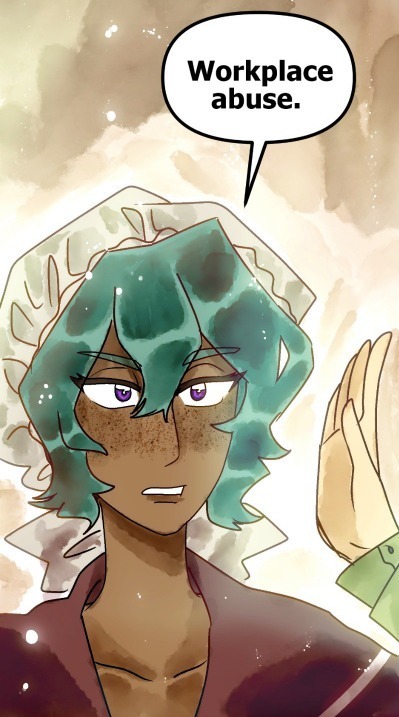
From this description, you might think this is going to be a smart comedy poking fun at some shitty manhwa tropes. I mean, maids in mahwas definitely treated as props for the main characters like 90% of the time. They have to either support the main character in everything she does (be their ‘personal ass-kisser’, as one of the characters in This Isekai Maid has put it), or be treated like garbage, no in-betweens. At least, that’s what I expected at first. But after only reading a few chapters into the story, I realised that the author approached the topic with way more depth, weight and nuance than I originally expected. The author said in a Q&A that the webtoon is partly based on her experiences working in customer service, and you can really feel it in every panel. I came into this comic thinking, ‘Haha, a parody of stupid manhwa tropes,’ and was slapped in the face (pun intended) with a painfully realistic portrayal of classism, nationalism, misogyny and xenophobia that still exhists in our world to this very day.

On top of that, the author plays around with other annoying aspects of otome isekai, like the problematic male lead who gets a pass for his horrible actions because he has a tragic past and ‘changes for love’ and the villainess who really wants to steal the female lead’s man just cause. The author gives all characters multi-dimensional personalities and motivations, but also acknowledges that explanation is not excuse.
TL;DR This Isekai Maid is Forming a Union! is a smart deconstruction of the bad otome isekai tropes which not only pokes fun of the genre itself, but also uses this opportunity to talk about some very real issues.
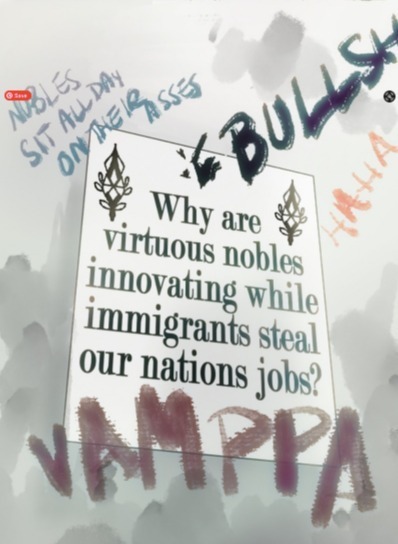
Check out this comic on Webtoon or Tapas and send love to the author @catesartworks here on Tumblr.
And if you’re still not convinced, here are some personal highlights. Keep in mind, these are big spoilers for episodes 13-14 and 19.
Personally, the moment I knew I was in love with this comic was in episodes 13-14. The ‘otome female lead’ has and encounter with one of the maids, Marina. Marina is described as being greedy, selling magical items without a licence and basically taking every opportunity to earn a little more. The ‘female lead’ believes her to be untrustworthy and slaps her to ‘put her in her place’. And Marina basically has a PTSD episode, she completely breaks down. We then learn more about her backstory and why she acts the way she does. It absolutely destroyed me and I loved every second of it.

Another one, in episode 19, we get a glimpse into the motivation of the ‘villainess’. She is supposed to be the ‘female lead’s’ love rival trying to steal her fiance. I always hated this trope where women in fiction are pinned against each other for the sole reason of wanting the same man. Well in this episode we find out that the ‘villainess’ is so set on chasing the ‘male lead’ specifically because he is not interested in her.

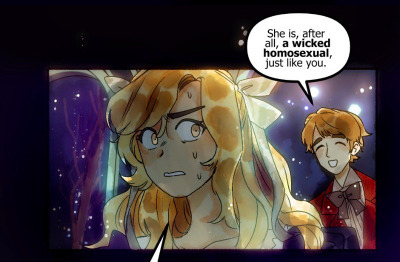
Someone in the comments called her a problematic girlboss, and she is definitely not a good person, but I feel like right now her character could go either way and I’m really excited to see that.
And this is not even close to covering everything that has happen in the story so far. I highly recommend you check it out.
#webtoon#manhwa#webcomic#manhwa recommendation#otome isekai#isekai#lgbtq#gl#lesbian#sapphic#yuri#wlw#shoujo ai#girls love
92 notes
·
View notes
Text
Wish (The things it did wrong, and the things it did right)

Merry Christmas and Happy Holidays. Welcome back to the House of Milesverse, our place for comic book and fiction talk. Today we are taking a slight detour to Disney's animated catalog.
2023 was an explosion of Disney hype and joy, due to celebrating 100 years since the company's inception. It was a year full of laughs, and shared memories. On top of this, a short film was produced to commemorate the franchise's anniverary.
Today we will be talking about Wish, an animated film that released in November of that year. The movie focused on a young girl wanting to set loose the wishes of her kingdom, kept captive by an evil king. She's joined by her plucky goat, and a hyperactive star that can grant wishes.
Wish was written off by many people, and considered an animation blunder by Disney fans. It failed to live up to the hype of people that expected differently than Disney's usual service. Some people however have found the film to be a fun, but far more average, experience.
Today we will go over the things Wish did right, and the things Wish did wrong.
The things it did right:
Right from the start, there's some key points to address in what Wish did right. Of the two opinions I mentioned, I agree with the latter choice. Wish is not a terrible film, but it is just a mildly okay one. What it has is genuinely good material that hits well.
Star plays well as a typical mascot:

The bright and speedy Star is our mascot (or one of two) for the film. He arrives in a blur to answer Asha's troubles. His arrival, however, is what kickstarts much of the film's conflict. The main antagonist, King Magnifico, wants Star for his power.
He's your typical Disney mascot character whose built for the audience to like him. Think Olaf from Frozen, a cute snowman whose made many a fan. Star plays into that exact demographic with his adorable, bright design.
I find Star's appearance to be infectious because of this. I could not help but laugh at some of his actions throughout the film. Plus he's an expert at granting wishes. Think of him like the silly Genie from Aladdin, but without Robin Williams' sheer charisma.
Asha dreams of adventure:

Our main protagonist is the kind and wishful (pun intended) Asha, voiced by Ariana DeBose. At first, Asha desires for the king to grant her grandfather's wish for his 100th birthday. However after it is declined, Asha's new goal becomes setting the captive wishes free.
I like Asha's motivations, because of how they are rooted in the idea of wishes. She just wants the best for everyone, and for them to experience it on their own. Asha fits into the Disney heroine mold, due to her compassion, bravery, and the driving force behind her goals.
It was a common misconception before release that Asha should have been the villain. People believed that her goals made her evil, or just plain irresponsible. She wanted to set all the wishes free, even including the 'dangerous' ones. Luckily, the film skips over these ideas completely, and for good reason, too.
The Teens are a reference that works well:

Moving on from our starry-eyed protagonist is her large cast of friends. Collectively known as the 'Seven Teens', they get up to funny shenanigans. Their antics and personalities never feel dry during the movie's run.
Beyond comedy relief, the seven teens are all distinct are distinct in a way. They are one of the few references from Disney media that I think actually work. The teens are, obviously, all based off of one of the Seven Dwarves. This callback from Disney's first real 'princess' film to its current one acts as a solid reference.
In addition, the teens also have a stake in the plot and offer tension to the story. They help their friend out, even when she's been ratted out as a traitor. Their personalities all shine through during the final act of the film.
Overall, the Seven Teens each have a counterpart in one of the Dwarves. These include:
Dahlia (Doc)
Simon (Sleepy)
Hal (Happy)
Gabo (Grumpy)
Bazeema (Bashful)
Dario (Dopey)
The things it did wrong:
Magnifico falls short as a villain:
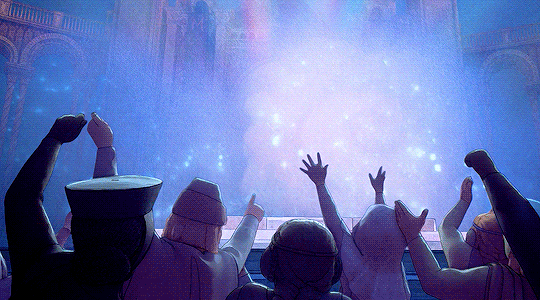
Brought to life by Chris Pine, King Magnifico is the main antagonist of the film. As mentioned before, he is the tyrannical ruler of Rosas, who harbors the wishes of its people for his own power. Magnifico is a narcissist who is only willing to grant wishes if he can benefit from it.
Magnifico's entire concept was meant to play toward the 'old' Disney villains. People have long enjoyed villains like Jafar from Aladdin, Maleficent from Sleeping Beauty, Scar from the Lion King, and more. Magnifico's personality, his lust for power, and even his green magic all call to mind traits associated with old Disney villains.
However, our untrustworthy king falls short in many ways. As a villain, Magnifico's transition to evil can come off as rushed. Much less time is spent on who he was before gaining his position. He spends a good deal of the plot hounding Star for its cosmic power.
You can say this for other villains in the franchise as well. However, I find that Magnifico suffers the most from this. He already has an interesting background set up in the story, but nothing is done with it.
In the past, Magnifico came from a loving family. He lived in peaceful lands until greedy thieves attacked. They killed his family and traumatized him. He wanted to learn magic so that he could use it to defend himself, and others.
Magnifico's worst qualities are always seen upfront throughout the movie. There is no lie that he's the 'bad guy' of the series. There's also nothing wrong with him being the main antagonist. However, Magnifico could benefit from gaining more sympathetic traits to better round out his character.
This is not me asking that he be a fully 'sympathetic villain' who was never evil to begin with. Instead, I believe that Disney had the option to still make him more complex. More than that, it would also make his transition to evil less jarring for some viewers.
Asha is another victim of the 'adorkable' trope:

Over the years we have seen heroines from Disney evolve. Starting with Rapunzel in 2013, most of them were much quirkier. This is what many refer to as the 'adorkable' trope. Characters who are socially awkward or unappealing but in a cute way.
Rapunzel, Mirabel, Moana, and Anna are all characters who use this idea in one way or another. They are put in awkward or quirky situations which also leads to easy laughs. I think it's worth noting that all of them use it well, at least.
With Rapunzel, she had never seen the outside world since she was a child. Mirabel's awkwardness came from her own feelings relating to her family. Both Moana and Anna are adorkable in their own ways, but neither of them is overwhelmed by the trope.
Asha feels like she is always on the verge of it. She's clumsy, nervous, and also awkward at times. I think this is a scenario where Asha didn't need these 'traits'. As adorkable as she can be, she already has a great narrative. Asha is compassionate, and you can feel how much she cares for her people.
The story hinges too much on the past:
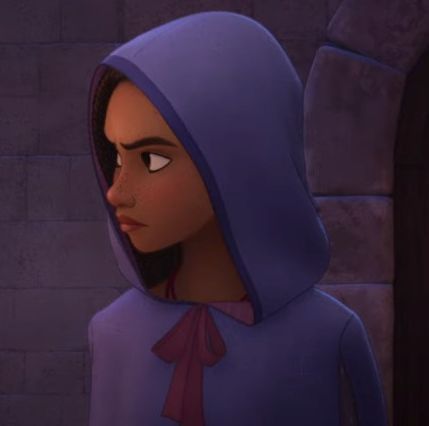
This is my own personal issue with Wish itself. Wish is a good story on its own, but it also relies on references from the past. The story is full of references to Disney media.
Some references worked in the story, however. The Seven Teens for example, were integrated well into the world. Asha's basic 'cloak' is a reference to the Fairy Godmother's garb, and it blends so well into her design. Magnifico's magic is green, calling to mind past Disney sorcerors and villains.
These are references that feel natural to the story because of how they are positioned. Everything else just feels like it's for the sake of being there. The references are there to feed you, meal after meal. However, like any person eating the same meal, you eventually just get tired of it.
The Music:

Wish's music is my favorite part of the film. Every sequence in the movie is loaded with loving tunes. I just can't help but smile whenever I hear the opening of "This Wish" or "This is The Thanks I Get?".
The songs partway carry the film for me because of how bombastic they are. The visuals help hammer in the Disney magic that you are used to. Each tune is filled with so many amazing sequences that you just won't get tired of seeing it.
The credit for this lies in musician Julia Michaels, and Benjamin Rice. Joined by JP Saxe, they helped create Asha's powerful anthem. The score of the movie was meanwhile composed by Disney's notable orchestrator, David Metzger. Metzger had also done work on other films such as Frozen, Wreck-It Ralph, Moana, and Tarzan.
Overall consensus: Wish is a movie that tried. And failed. But maybe that's okay?
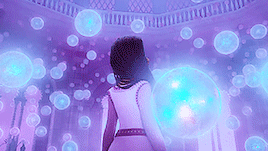
Wish is a film that tries to do too much, and that only hinders it. It's a movie that tries to be a large, huge spectacle. It is Disney's celebration of the fans with all these easter eggs and hidden catches. That aspect is where Disney loses its magic, and it is what hurts the film.
Wish is so caught up in being the ultimate milestone celebration that it forgets to be a movie. Everything about Wish, when it is focused on its own story, adds charm and substance. The concept of how Wishes work, as aspects of real people, is brilliant.
The nature of the film alone created a lot of hype for fans. People were expecting a much bigger ordeal than what they got from the film. Because of this, it was guaranteed to create dismayed reactions from those same fans.
This is not to say the film is terrible or that it has no purpose. Wish is a beautiful-looking film that is just alright. That on its own, is what makes the film entertaining to me.
Wish is a flawed film, but one that I enjoyed nonetheless. It is a movie carried by its bright cast. I would recommend that you see the movie for yourself, instead of listening to other people. That way, you can form your own opinion on the movie.
3 notes
·
View notes
Text
Outen no Mon/Deep Sea
youtube
The Tale of Young Sugawara no Michizane
Outen no Mon the show made me want to read the manga. Reading the synopsis, I originally joked with friends that this was just another Heian era swashbuckling mystery thriller or Onmyoji knockoff sans magic. It is not just another Heian era swashbuckling mystery thriller, it is…different enough to be called unique. Where Onmyoji was basically tale of a smartass, debauched sorcerer and straightlaced warrior who overcome their differences to save Heian-kyo to comical effect; Outen no Mon is about a smartass, bookworm scholar and playboy warrior who overcome their differences to save Heian-kyo. As in any story set in Heian-kyo, it is haunted. No wonder onmyoji business was booming during that era. The difference is in Onmyoji the ghosts are real while in Outen no Mon the real danger lies in man. As for the chick in the team, the immortal priestess is replaced with an imports and antique dealer who is probably also running a sweatshop of counterfeit goods. But she has a good heart and uses her talents in service of the protagonists so don’t worry about it.
Characters:
In summary we have the brains, the brawn, and the street smarts for our protagonist team of investigators. They can also be classified as middle class (Sugawara no Michizane), aristocrat (Ariwara no Narihira), and peasant (Shouki). They are performed by our triple moon tops: Tsukishiro Kanato, Houzuki An, and Umino Mitsuki respectively. (I just realized the tops and niibante of moon troupe all have moon in their name. Coincidence? ^^;) This is my second non-romantic Takarazuka show in a row. First I got a politically-charged Chinese historical fiction and now I got a politically-charged Japanese historical fiction. In other words, this show tends to focus on the mystery and we follow the friendship of Michizane and Narihira more closely than anything Shouki is doing. Reiko and Chinatsu portrayed their respective roles and contrasted each other admirably. Michizane as a character is a shut-in bookworm and apathetic to the machinations of the court, choosing to mingle with the commoners whom he feels kinship with. This often manifests as dressing casually to see the Emperor. In the manga, he is a classic shounen hero with a difficult, socially awkward personality but still a morally upstanding citizen. Reiko’s version is a bit more socially competent and suave because she is a Takarazuka hero. Her Michizane comes across as an introverted and introspective youth rather than full hikikomori. Since we aren’t privy to internal monologue in this staging, this is probably a better approach for presenting the main character.
Then we have Chinatsu as Narihira, resident playboy and military officer responsible for the safety of Heian-kyo. While being a nepo-baby nobleman, he does take his job seriously and is open-minded. His haughtiness and discrimination against the peasants is a result of ignorance rather than him being a dick and his friendship with Michizane begins with him opening his eyes to the plight of the disenfranchised. I feel the fanservice was toned down compared to usual Takarazuka fare. Narihira is so blasé about his charms. Instead of a dramatic pose or drawn out moment where he puts his flirt on, he’s just going about his day and doing his job. He just throws out a wink or wave while on patrol but marches professionally on when he’s on the clock even if fangirls are present. That strikes me as a different portrayal of playboy from the norm. Houzuki An is certainly one who would know she is suave without overcompensating. XD Her makeup didn’t photograph well in some angles and I think she was attempting an old man but sexy look as Narihira is considerably older than Michizane. Chinatsu’s voice is divine and it’s strong enough to carry. Couple times she nearly blew out her mic in both the show and revue. Also, I swear she had more costume changes than the Top Star since she’s playing a man of society so we saw her in dress uniform, street uniform, casual ensemble, etc. On the other hand, Michizane is a maverick scholar known to be a slob who even dares to come to court in the Heian version of sweatpants and T-shirt so Tsukishiro Kanato is usually in the same outfit.
As the political intrigue features heavily in the story, the show is a bit of a sausage fest so there isn’t much for musumeyaku to do. There are only three named female roles of note so it makes sense that Eri would take the biggest female role. Shouki is a fun character in her own right and has no romantic subplot as a shrewd businesswoman and an equal member of our intrepid trio. She is the ingenious friend who provides the resources to make Michizane’s plans a reality. It is a refreshing role for a musumeyaku, who usually get stuck as love interests. Of course, there is star-crossed romance on the side in case seinen is not your genre. Narihira and Takako were lovers who tried to elope in their youth but circumstances of birth have rendered their relationship forbidden. They resolve this the mature, Japanese way (those of you who watch Japanese historical dramas know what I’m talking about). For a side character and love interest, Takako is a complex character with her own personality and drive despite her vulnerable social circumstances that Amashi Juri brought to life. Generally, the female characters were well-developed and interesting even if sparse.
Kazama Yuno as Fujiwara no Mototsune is practically a lead character and a complicated antagonist. He doesn’t have much depth to him as cold and calculating Fujiwara Jr who does most of foster dad’s dirty work. However, his relationship with everyone else makes him interesting. He had a not-negative acquaintance with Kisshoumaru, Michizane’s deceased older brother. However, his younger brothers were responsible for Kisshoumaru’s death. Thus, Mototsune and Michizane’s relationship is awkward to say the least. If his solo number is any indication, he really did consider the Sugawara brothers as friends and misses their childhood romps while regretful about the harm his dick younger brothers inflicted. Mototsune hasn’t completely gone to the dark side yet, perhaps due to him being a distant relative adopted into the main branch of the Fujiwaras or his youth. Him and Takako are on the same boat as adoptees from a lesser branch of the family so he is more sympathetic and softer towards her. He’s also willing to give respect when it is due, even if it is for the opposition.
Those are the characters worth mentioning. The supporting cast do their jobs. The two child characters are comic relief running around to sing the praises of Michizane’s genius. Groups of women serve to showcase how corruption has disenfranchised the poor or as fangirls to promote Narihira’s star stud status. The Sugawara household are a wholesome and supportive family who are scholarly and down to earth. The Fujiwara household is…evil. I joke but they portray a toxic and strained family. Half are spoiled, despotic fools hiding behind the family name while the other half are miserable, calculating souls forced to make sacrifices and make up the slack of the former. The emperor is young, naïve, and weak. But he is always that way in any media featuring the corrupt Fujiwara puppeteering the throne (an actual stretch of history Japanese media love to defer to). Overall, a strong cast from Tsukigumi!
Plot:
Story wise, it was a good opening but as the manga is ongoing and probably quite lengthy, it feels like we just completed an arc. The arc is specifically about a demon parade harassing the streets of Heian-kyo that kills hapless citizens caught in its path. By imperial decree among other circumstances, our main characters find themselves working together to stop the murders and uncover the truth of the matter. The mystery of murder-ghosts was resolved but a lot of the interpersonal conflicts remained open-ended. And what I mean by resolution is the streets are safe again now that the murderers are arrested but we never learn the motive or discover the mastermind. In this respect, the musical did end a bit abruptly. Regardless, I enjoyed the pacing, intrigue, and story immensely.
The plot was quite rich. There is the main plot of why there’s a demon parade abducting people at night. Michizane deduces this is a more earthly problem and together with his crew they catch the culprits. Additionally, we are given lots of political intrigue with a naïve young Emperor being controlled by the Fujiwara clan. Papa-Fujiwara is such a social climber he’s adopting all his country bumpkin relatives to be his pawns in court. His heir is an adopted son and now he’s acquired a new daughter he’s trying to shove into the emperor’s harem. Someone wants the emperor dead and someone is using the emperor for their own ends, all fingers point to the Fujiwaras but they are untouchable. There are many layers to this show.
The character relationships are also complicated and the conflicts hit in the feels. The main character is disenchanted with the Japanese court and is struck with wanderlust so strong he wants to go abroad and explore broader horizons. He has big dreams and genius to match but is hampered by politics and domestic issues. Reiko explains all of this in song form! You have hard-working and practical Shouki who may be doing some shady business but the economy is bad and the system is against her. Narihira and Takako are pining for each other, but are unable to reconcile their duty to family and their own pride. Theirs is a bittersweet ending. Mototsune has a lot of internal conflict to sort through but being a corrupt politician is hard work. The list goes on. I wasn’t moved to tears but was invested in the characters.
The musical is definitely plot driven. I had more of an impression of that and the character development than I did of the musical numbers, which informed the story rather than serve as earworms. The diegetic dance sequence in the imperial court was the only memorable number. This was a grand dance number where Takako was meant to perform and seduce the emperor. Then it transitions to the investigating trio being forced to duet together while they try to protect the emperor from assassination without ruining the banquet. Lots of flashy bird costumes in this scene. The court ladies are doing some sort of crane or heron dance with not-Takako at the center in a silver crane costume equipped with anachronistically showgirl style headdress. Then Michizane and Shouki perform what appears to be a mandarin duck dance (based on the costume) but are interrupted due to Murphy’s law and lots of plots so Narihira has no choice but to take Shouki’s place. Read into that what you will. While the emperor has his attention on the stage within the stage, the audience is focused on the surrounding intrigue.
Overall, I quite liked it. Now I will go read the manga and see how it compares.
The Carnival of the Sea Gods
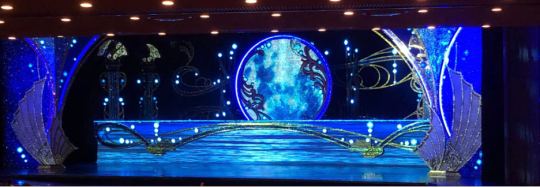
After such an amazing show, I was underwhelmed by the revue. Deep Sea? More like “Glitter Cabaret.” The theme was very subtle, which can be creative genius or WTF. It was leaning towards the latter for me. There were some ideas I liked such as the jellyfish tailcoats and personified pearls representing inspiration, courage, and hope. The Mariana Trench episode was an interesting direction… Not all the ideas hit. There were some snappy tunes but nothing memorable. Lots of spicy Latin flavor such as tango, frills, spurned lovers, etc as advertised. This revue was very shiny. Blindingly so at times. That is my biggest impression of it.
The revue was a hit-or-miss, but that is just my opinion. My neighbors were significantly more impressed. Amazingly enough, I was surrounded by sweaty dudes. One grandpa was camped out with all his binoculars including a piece of equipment fit for birdwatching. He was regularly switching between binoculars during both show and revue. Another gentleman was clearly looking for a specific seito, perking up at specific times. All the gentlemen fans noticeably leaned forward during the rockettes number. No judgment there, Takarazuka entertains all!
#takarazuka#theatre#theater#takarazuka revue#ohten no mon#outen no mon#musical#tsukigumi#moon troupe#houzuki an#tsukishiro kanato#reiko#chinatsu#umino mitsuki#umi#eri#宝塚歌劇団#宝塚#月組#応天の門#deep sea#shounen manga#manga#月城かなと#鳳月杏#海乃美月#my thoughts#my meta#my ramblings#my rambles
18 notes
·
View notes